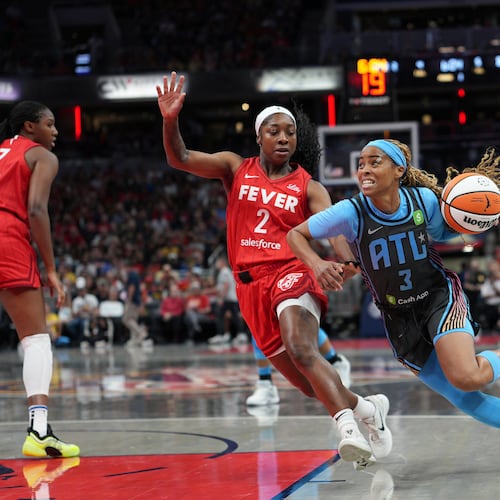Georgia State’s attempts to defend the run last year weren’t very successful. (Jason Getz-USA TODAY Sports)
We will continue the Optimist vs. Pessimist series with the question that will most likely determine Georgia State's win-loss record this year: Are the Panthers better at stopping the run? This is not hyperbole, as you will read, but it would be difficult to perform as poorly as they did last year.
The facts:
- Georgia State allowed 303.4 rushing yards per game last season, 124th out of 125 teams.
- Georgia State allowed 6.3 yards per rush, tied for last out of 125 teams.
- Georgia State allowed 41 rushing touchdowns. That's more than the Panthers scored rushing and passing.
- Opponents rushed 582 times against Georgia State. That's 136 more rushing attempts than Georgia State had passing attempts.
- Georgia State was outscored 520-272 last season.
- Just one opponent failed to eclipse 100 yards rushing. Every other opponent rushed for at least 182 yards and Georgia Southern rushed for 613 yards.
The optimist says
"First and foremost we have better players. They are older, they are stronger. They worked their butts off this offseason with Coach Holsopple. Added in some guys in the front seven. The way we ended the season, we could have 5-6 new starters in the front seven at either a different position, a guy that came back from injury or a new player. I feel like we've added some pieces. Studied some things schematically that we think will help us." Defensive coordinator Jesse Minter
The pessimist says
Georgia State’s players are older and stronger, but so too are the opponents. The only difference may be is if Georgia State wasn’t maximizing its offseason strength and conditioning programs in past years, and did this year. That would mean the players are truly competing equally.
The optimist says
The run defense only needs marginal improvement to turn last year’s one-win season into a possible five- or six-win season.
The pessimist says
That would seem true, but even minimal gains can be difficult to make. Esteemed colleague Ken Sugiura did some research about improvement in yards per play for a story he wrote earlier this week. What he found:
Looking at a pool of 82 defenses that finished between 101st and 121s in yards per play in the 2010-13 season, 52 teams, or 63 percent, remained in the bottom third in FBS in yards per play the following season. There were 23 teams, or 28 percent, that moved into the middle third. Only seven defenses, or 9 percent, made it into the top third.
There is a difference in rushing yards allowed and yards per play, but there is a correlation between the two. Even marginal improvements can be difficult, but not impossible, to achieve.
The optimist says
The new starters (Mackendy Cheridor at defensive end, Kaleb Ringer at inside linebacker, Alonzo McGee at linebacker) will bring an influx of competition and talent.
The pessimist says
They may make a difference, but the two players closest to the ball, nose tackle Jalen Lawrence and defensive end Shawayne Lawrence, are still with the first team, as they have been the past two years. For lots of reasons (scheme, personnel, etc), they haven’t been able to make many plays so why expect any change this year? If opponents can continue to run up the middle and get 3-4 yards before the linebackers get there, it’s not going to make that much of a difference.
The optimist says
The Lawrences have another year in the scheme, which means they should be able to just play and not have to think. Jalen Lawrence said he knows and understands the defense this year so much better than he did last year.
The pessimist says
Just like the gains made in strength and conditioning, this seems like a wash because the opponents they will face will also have another year learning their schemes. Knowledge is always good. But it’s usually not one-sided.
Plus, and this should be scary part for Georgia State's fans: seven of the conference opponents return at least five starters on offense. Five return at least seven, four return at least nine (barring injuries, suspensions, etc.) That's a lot of experience and a lot of memories of what happened the last time they played Georgia State.
The optimist says
The schematic changes that Minter mentioned should help the defense improve.
The pessimist says
We will see. I doubt the offenses they face will run exactly the same thing they ran last year.
The optimist says
The depth added in the offseason with DeQueszman Kelley and Julien Laurent will enable the coaches to rotate players in and out on the line, keeping them fresh for the entire game and season. The linebackers are also deeper than they have ever been.
The pessimist says
That is true. The only variable is that many of the offenses in the Sun Belt run the hurry-up, which means substitutions can usually only be made on alternating possessions, and not during possessions. It’s hard to get a feel for what’s going on if you don’t continue to face something over and over.
The optimist says
The offense should be able to run the ball more effectively, which will limit the time the defense has to stay on the field.
The pessimist says
That is true. But the offense won’t get a chance to run the ball if the team falls behind quickly, so we will see.
What say you?
Will Georgia State’s run defense be better this year?
About the Author
Keep Reading
The Latest
Featured



